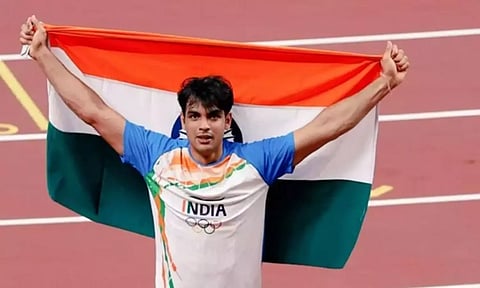

NEW DELHI: After the star turns of the Chandrayaan-3 scientists and chess prodigy Praggnanandhaa in the past two weeks, it was the turn of India’s athletes at the World Athletics Championships in Budapest to put a smile on our faces. Javelin star Neeraj Chopra won the first-ever gold for India at these championships, following up on the gold he won at the Tokyo Olympics in 2021. His second throw of 88.17 m was sufficient to ward off the thrilling challenge of Pakistani javelin star Arshad Nadeem. As at Tokyo, Chopra was confident going into his throws, not bothering to even track the flight of the javelin. India now has a great champion who thinks he is second to none — something to inspire youngsters in the years ahead.
Apart from Chopra’s stupendous success, there was a lot for India to feel gratified. India’s 4x400 m men’s relay team of Muhammed Anas Yahiya, Amoj Jacob, Ajmal Variyathodi and Rajesh Ramesh ran an electrifying race in the heats to qualify for the final of the blue riband event. This was the first time ever that an Indian track team has raced in elite company. It’s a sign of our vast improvement in track and field events that three Indians figured in the top eight of the javelin event. While Chopra took the gold, Kishore Jena finished fifth and Manu DP took the sixth spot.
Our successes on the world stage have been few and far between, but the gap between one success and the next is dwindling. Indian athletics could soon see a trickle of gold, growing into a torrent thereon if the rate of improvement accelerates. This was the first ever Indian gold at the World Athletic championships since we started participating in 1983. Anju Bobby George made the breakthrough for India in 2003 with a bronze medal in the women’s long jump. After a 19-year hiatus, Chopra won a silver in 2022, following it up with the gold this year. In the wider Olympic arena too, India’s successes have become more frequent since Leander Paes’s bronze at the Atlanta Games in 1996. Starting with solitary successes by Karnam Malleswari, Rajyavardhan Singh Rathore and Abhinav Bindra, India’s medal haul has grown to seven in the Tokyo Olympics.
It’s not a lot but there’s hope of a golden harvest. This is how emerging nations with low ranking on socioeconomic indices get started on the Olympics curve. As human development indicators, especially involving infant mortality, women’s health parameters and children’s nutritional status improves, it shows in the standards attained in the sporting arena. When economic development and social equality parameters break through a threshold, it leads to significant success in sports. The string of successes enjoyed by the likes of US, China and Australia will hinge on how well-tuned a nation’s sports development policies are. The alchemy of Olympic success for nations is a function of democratic access to sporting facilities and equipment, modern coaching, specialised dietary guidance, and professional motivational methods.
India will take many faltering steps towards that goal, but we will get there. We need social harmony — that allows citizens to aspire for success amid peace rather than discord. The Indian team that ran that audacious race in the semi-finals of the 4X400 m comprised two Muslims, one Christian and one Hindu. What can be more harmonious than that?